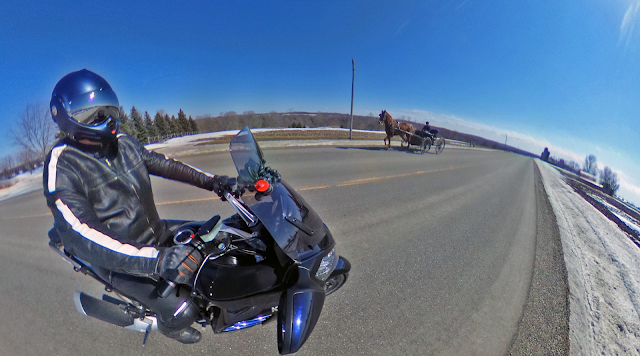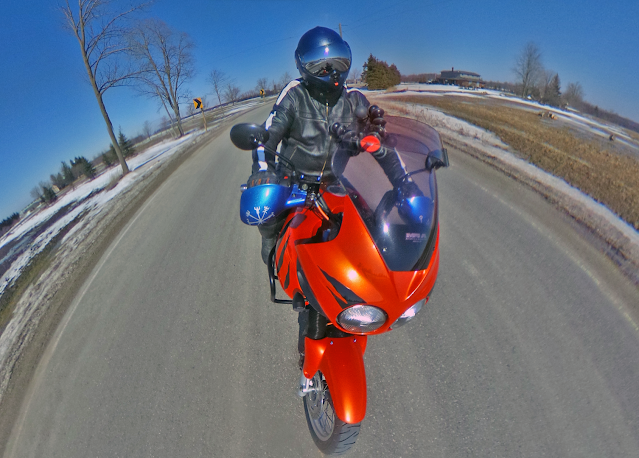It's my first time doing a motorcycle swingarm so I knew it would be a learn-as-I-go experience. Today I reinstalled the swingarm and that was definitely a case of learning as I go. I hope this post saves you a lot of swearing because I've already done it for you.
I had to lever the swingarm out with a tire iron, it's a tight fit in the frame. Removing it was tricky but reasonably straightforward with the some leverage between the engine and the swingarm.
Undoing the top bolt on the shock was a bugger (it's in an awkward spot inside the frame) but small motions over and over again eventually got it loose. The Chilton manual says to remove the exhaust system entirely (which also means the oil cooler and radiator), but that seemed like a big faff. Adrian Molloy .com had some good advice: instead of taking half the bike apart just take the swingarm out with the rear shock attached then dismantle it off the bike. Not sure what Chilton's thinking was in removing half the motor to get the swingarm out, but removing the rear shock with it is a much more efficient approach.

I cleaned up surface rust on the top of the rear shock and rust painted it. After cleaning the unit it was still in good shape otherwise so I let the paint dry overnight and then aimed to service the swingarm and reinstall it today, which turned out to be a bugger of a job. The right side sleeve in the swingarm pivot wasn't turning but the left side came out easily and still had grease on it. I lightly heated the swingarm and tapped it through with a 15mm socket bit that fit the sleeves perfectly. I then cleaned them up and got the bearings turning before looking them over. Once freed up they got a thorough cleaning and re-greasing using the
Mobil XHP222 grease Triumph recommends. The stuff that came off wasn't the same colour (dark red instead of grey), so I suspect whoever was in there last ju
st threw on whatever they had on hand.
Installing the swingarm was another bugger of a job. It's a tight fit and has thin washers that sit between the swingarm and the frame. They move around when you're trying to squeeze the swingarm into the frame and drive you around the bend. You can see them in that picture in the middle. Every time you squeeze the swingarm in it pushes the washers out of place. I put a 14mm socket in which holds them in place, but it's a finicky process that I just couldn't get right.
What finally did work was loosening the engine mount nut below the swingarm that holds the frame so tight to the swingarm. Loosen that off and you can install the big through bolt into the the left side of the frame with that side's washer in place and then thread it through the swingarm. Once the engine mount bolt is loosened off you can the slide the wash in on the other side and then finish pushing the big swingarm retaining bolt though before tightening everything up again. Needless to say, I greased the hell out of all that too.
There might be a way to install the swingarm with those fussy washers another way, but it was beyond me and I was running out of expletives. Loosening off the engine bolt is a top tip for swingarm installation.
I'd also recommend you do the swingarm service if you haven't as mine was essentially seized on one side even though it was in good shape otherwise. I think the bike's going to feel much more responsive as a result thanks to all the chassis lubrication and maintenance I've been doing this winter. Below is what that engine mount nut looks like (above the exhaust and under the swingarm). Loosen that off and the swingarm installation is straightforward.
The lower bolt that holds the shock in place on the swingarm is always awkward as it lines up with the exhaust pipe (which is probably why Chilton wants you to remove the whole exhaust system along with the radiator and oil cooler necessitated by that). Since the rear shock just drops out with the swingarm that seems like a wrong headed way to do it, but what do I know? Once it's out the lower bolt for the shock is easy to access.
Everything is moving freely and easily back on the bike. My weekend's up but I'm hoping I can get the back wheel on this week and finalize all the bits and pieces on both the front and back ends. That'll end the chassis maintenance portion of our program which included:
- front fork removal, cleanup and new fork oil
- reconditioned the fork gaiters (was going to replace them but reconditioning did the trick)
- triple tree removal, cleanup and regreasing
- swingarm removal
- rear shock cleanup and reconditioning
- cleanup and regreasing of swingarm pivot
Unmentioned but something I also did while things were in pieces were the brake lines that now have new, custom
Hel performance brake lines on them. They look fantastic, installed well (the kit had all the hardware including new hollow bolts as well as washers) and make a nice, not-so-subtle (they're SUPER ORANGE and disco blue) upgrade to the brakes. They should offer better response than the stretched, old rubber hoses that were original to the seventeen year old Tiger.
When you've got the front end out installing the brake lines is easy. Same with the back end, so why not do it while access is easy? The brake fluid was due a change anyway as I last did it in 2017, so the lines weren't that expensive because the bike would have been getting new DOT4 fluid anyway.
Some advice on brake fluid: don't buy a big bottle as once you've opened it time is ticking because the stuff absorbs moisture. Just get what you need and no more. Keep it sealed when you're not using it and use it as quickly as you can. I'm about half way through a normal sized bottle of DOT4 having bled the front brakes. I should be able to bleed the rears on that one bottle and then not have the rest going off.
To dos this week include:
- install the newly rear tired rim on the swingarm
- finish the rear brake line install and bleed it (can't do that until the caliper's back on the disk)
- go over all the fasteners front and rear and make sure they're all torqued up right




















































